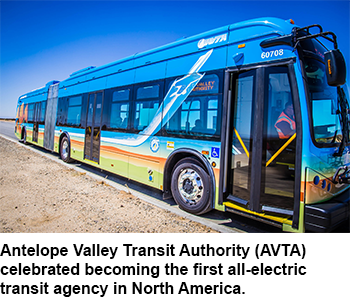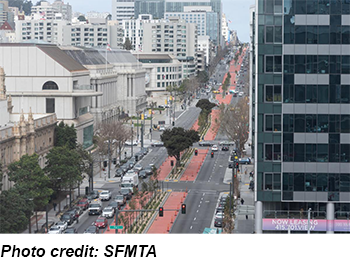The following items are excerpted or summarized from news releases issued by the California Transit Association members. If you are a member of the Association and would like to submit an item to be considered for inclusion in the Member News Library, please email your press releases to Managing Editor Jacob Herson (jake@caltransit.org). Photos and cutline information with your news release submissions, when possible, are encouraged.
Antelope Valley Transit Authority Becomes First All-Electric Transit Agency in North America 
On March 16, 2022, the Antelope Valley Transit Authority (AVTA) celebrated becoming the first all-electric transit agency in North America. The agency operates 57 full-size battery-electric buses, along with 20 commuter coaches and 10 micro-transit vans. Taking advantage of its Mojave Desert location, AVTA has also started a solar power installation and storage project to power the buses entirely with solar energy.
California Air Resources Board (CARB) Chair Liane M. Randolph congratulated AVTA and the Board for achieving a goal 18 years earlier than the requirement identified in California’s important Innovative Clean Transit regulation. “The Antelope Valley Transit Authority, together with the cities of Lancaster and Palmdale and Los Angeles County, has shown California and the world how local growth can coexist with clean transportation, low-carbon energy, and new local job opportunities,” said Randolph. “Their accomplishment underscores the fact that committed and visionary communities are key to our clean air and climate solutions as well as a strong California economy.”
AVTA’s board of directors decided to embark on this journey in 2016. The agency has received more than $44.2 million from the state and more than $52 million from the federal government for its electrification effort. AVTA received its first 24 battery-electric buses in 2021. They have since travelled more than 7 million electric miles, saving more than 1.7 million gallons of diesel and more than $2.3 million in operating costs, according to AVTA documents. The project has reduced greenhouse gas emissions by nearly 42 million pounds and resulted in measurable air quality improvement. The Antelope Valley Air Quality Management District reported a drop in the number of days with ozone levels at a dangerous 75 parts per billion from 64 in 2003 to just one in 2021.
San Francisco Municipal Transportation Agency Opens Van Ness Bus Rapid Transit Corridor 
San Francisco Municipal Transportation Agency (SFMTA) officially opened the Van Ness Bus Rapid Transit (BRT) Corridor with a ceremony on April 1, 2022. Red dedicated transit lanes allow SFMTA and Golden Gate Transit buses (as well as emergency vehicles) to travel independent of car traffic in the center of the avenue while Transit Signal Priority gives them green lights as they approach intersections. With nine new fully furnished boarding platforms, low-floor vehicles, and all-door boarding, the BRT system will reduce travel times by a projected 32 percent, making the Van Ness Corridor the fastest way to travel north-south in this part of the city.
“Today marks a significant step forward in our effort to transform transit safety and efficiency along one of San Francisco’s busiest corridors,” said Mayor London Breed. “Not only does this project make Van Ness Avenue a more enjoyable place for residents and visitors to walk, bike, and take public transit, it also helps get people out of their cars. In order to have a San Francisco that is livable and healthy for our residents, we must reduce emissions from transportation and make it easier for people to get around in more sustainable ways.”
The Van Ness Improvement Project included a major and much-needed upgrade of subterranean infrastructure. More than 22,000 feet of water mains and sewer pipes, some over a century old, were replaced. New utilities are equipped to withstand earthquakes and the impacts of climate change. The emergency water supply system was also overhauled. This system was built soon after the 1906 earthquake, during which, damage to the water mains prevented firefighters from stopping the fires that ravaged the city.
Funded by Federal Transit Administration (FTA) Formula Funds, Prop K funds, developer contributions, and other sources, the project also includes extensive street-level improvements. Bulb-outs extend sidewalks at intersections to shorten the distance for pedestrians crossing the street. Median refuges provide pedestrians a safe place to wait to cross. Countdown signals indicate how long people have to cross, and accessible auditory pedestrian signals provide verbal directions to bus platforms for people who are blind and low vision. The project also includes streetlights and sidewalk lighting, landscaping, new trees and shrubs, new sidewalks, and a colorful public light sculpture on the Geary/O’Farrell boarding island.
Santa Cruz Metropolitan Transit District Names Michael Tree New CEO/General Manager
Santa Cruz Metropolitan Transit District (Santa Cruz METRO) has named Michael Tree its new CEO/general manager, starting April 25, 2022. Former CEO Alex Clifford announced his departure in November.
“Following a nation-wide search and many hours of work by our recruitment team, I’m happy to announce the appointment of Michael Tree as Santa Cruz METRO's new CEO/general manager," said Santa Cruz METRO Board Chair Larry Pageler. "We’re excited by his extensive expertise and knowledge of public transit as well as his proven track record in increasing connectivity for the public. We look forward to Michael expanding our zero-emissions bus plan so METRO can continue to reduce our emissions and our impact on the environment.”
Tree has more than 27 years of experience in the public transit industry and city management. His most recent experience as executive director of the Livermore Amador Valley Transit Authority (LAVTA) focused on increasing the agency’s transportation options to improve ease of use and connectivity for riders. This resulted in an increased number of Rapid Routes with 15-minute, all-day frequency and expanded travel options for passengers with disabilities.
While Executive Director of LAVTA, Tree was also the executive director for the Tri-Valley-San Joaquin Valley Regional Rail Authority, a new rail authority created by the state to plan and deliver the 42-mile, seven-station Valley Link commuter rail project. Tree has been named Transit Manager of the Year by both the California Association for Coordinated Transportation and the California Transit Association. In 2020, LAVTA was named the North American Transit Agency of the Year in its category by the American Public Transit Association.
“I’m excited to lead METRO into its next chapter,” Tree said. “The future holds opportunity for Santa Cruz METRO to improve the quality of life for residents through better connectivity, especially for those who are disadvantaged.”
Riverside Transit Agency Breaks Ground on Vine Street Mobility Hub
Riverside Transit Agency (RTA) hosted a groundbreaking ceremony on April 8 for the Vine Street Mobility Hub. Expected to be completed in 2023, the five-acre site across from the Riverside-Downtown Metrolink Station will include two central bus islands, each with custom overhead solar-powered shelters and amenities such as seating areas, information kiosks, and real-time messaging signs. Plans call for 16 bus bays, a community plaza, shade structures, and greenspace. The event was attended by members of the RTA Board of Directors, city and county lawmakers, community partners, and officials from Los Angeles Engineering, which is building the facility.